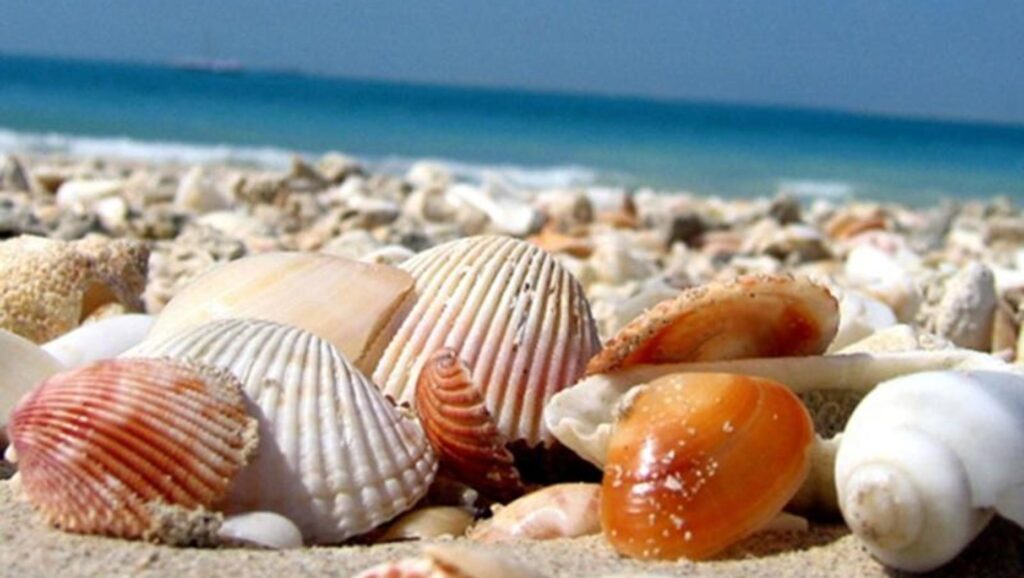
The lines on a seashell are typically growth lines or ridges that indicate the shell’s incremental growth. As a mollusk grows, its shell must also increase in size. This expansion happens in a step-wise fashion, with the mollusk secreting new material at the edge of its shell. These lines can be thought of as a record of the shell’s history, with each line representing a period of growth which could be influenced by the mollusk’s environment, availability of food, or changes in water temperature.
What do the Ridges on Shells Mean?
Ridges on shells serve multiple purposes. Structurally, they add strength to the shell, helping it withstand external pressures and predation. Ecologically, the ridges can affect the shell’s hydrodynamics, influencing how mollusks are carried by water currents, which can impact their dispersal and feeding. Aesthetically, these ridges can interact with light and color, often contributing to the shell’s appearance and potentially playing a role in camouflage or attracting mates.
Why do Shells have Stripes?
Stripes on shells, like other patterns, may arise from a variety of biological and environmental factors. Biologically, the patterning can be controlled by genetic factors that dictate pigment deposition as the shell grows. Environmentally, factors like changes in diet, water temperature, or exposure to sunlight during the shell’s development can influence the appearance of stripes. Stripes can serve as camouflage, blending the shell with its natural environment to protect it from predators.
What are the Patterns on a Seashell?
Patterns on a seashell, including stripes, spots, and more complex designs, are primarily the result of the shell’s growth process and the genetics of the mollusk. These patterns are formed by pigments deposited in the shell’s calcium carbonate structure. The specific pattern can serve various functions, including camouflage, species identification, and sexual selection. Intricate patterns can also deter predators by breaking up the shell’s outline or mimicking other environmental elements or organisms.
How Seashells are Made?
Seashells are made by marine organisms known as mollusks. The process begins with the mollusk secreting a shell from a part of its body known as the mantle. The shell is primarily composed of calcium carbonate, which is deposited in a crystalline form known as aragonite or calcite. These minerals are often combined with a protein matrix to form layers, which collectively contribute to the strength and structure of the shell.
The creation of a seashell is a continuous process throughout the life of a mollusk. The shell starts small when the mollusk is young and grows as the animal grows. The size, shape, and texture of the shell can vary widely among species, influenced by genetics and environmental factors.
Exploring the Ecological Roles of Seashell Patterns and Textures
Beyond their aesthetic appeal, the patterns and textures on seashells play crucial ecological roles. For instance, the specific textures might influence the mollusk’s interaction with its habitat. Rough textures can help seashells blend into coarse sandy or rocky environments, acting as a form of camouflage. On the other hand, smooth shells might be more common in areas with fine sediment, helping the shells to reduce friction as they move or are moved by water currents.
The Importance of Seashells in the Ecosystem
Seashells also serve significant ecological functions once their mollusk inhabitants have died. Empty shells provide habitats for a variety of marine organisms. Hermit crabs, for instance, rely heavily on finding suitable empty shells to inhabit for protection. Additionally, seashells contribute to the biogeochemical cycling of calcium carbonate. They can influence the pH of marine environments by slowly releasing carbonate compounds back into the ocean, which can help buffer against ocean acidification.
Seashells as Indicators of Environmental Health
Seashells can also act as indicators of environmental health. The rate of shell growth, as well as the quality and thickness of the shells, can provide important clues about the state of the local environment in which they are found. For instance, areas polluted with heavy metals might show a prevalence of thinner, weaker shells due to the inhibitory effects of these contaminants on calcium carbonate deposition. Thus, monitoring seashell quality and abundance can be an essential tool for marine biologists and environmental scientists.
The Role of Seashells in Human Culture
Finally, seashells have played a significant role in human culture and history. From being used as currency in various indigenous trade systems to inspiring art and architecture, seashells have been integral to human societies across the globe. They continue to be valued not only for their inherent beauty but also as scientific specimens, jewelry, and decorative objects.
Seashells and Scientific Research
The study of seashells extends into various scientific fields including biology, ecology, paleontology, and even material science. Researchers analyze seashell composition and structure to understand better the evolutionary adaptations of mollusks and their response to environmental changes over millions of years. For instance, the fossilized shells found in sedimentary rock can provide valuable information about the historical climate conditions and how marine ecosystems have evolved.
Material Science and Seashells
In material science, seashells are studied for their remarkable mechanical properties, such as strength and resilience. The hierarchical structure of seashells, where hard mineral layers are interspersed with soft organic matter, inspires innovations in biomimetic materials—materials engineered to mimic the properties of natural examples. This research has potential applications in creating more sustainable forms of concrete, ceramics, and even body armor, which could emulate the tough, yet lightweight characteristics of seashell structures.
Seashells in Education
Seashells also provide an excellent resource for educational purposes. They are commonly used in classrooms to teach students about marine biology, ecology, and geology. Handling seashells can help students understand concepts like adaptation, the role of ecosystems, and the biodiversity of marine life. Additionally, seashells can introduce students to environmental issues such as habitat destruction, pollution, and the consequences of climate change on marine environments.
Conservation Challenges
Despite their abundance, many mollusk species that produce seashells are facing threats from overfishing, habitat loss, and climate change. Ocean acidification, a direct result of increased carbon dioxide levels, particularly threatens mollusks by making it harder for them to produce and maintain their calcium carbonate shells. Conservation efforts are crucial to address these threats, involving habitat protection, regulations on shell collecting, and efforts to reduce carbon emissions.
Engaging the Public in Shell Conservation
Public engagement is essential for the conservation of mollusks and their habitats. By educating people about the importance of seashells beyond their beauty, conservation groups can inspire more active participation in protecting marine environments. Initiatives like beach clean-ups, sustainable tourism, and citizen science projects involving seashells can help raise awareness and foster a deeper connection between people and the marine ecosystems.
The complexities of seashells extend far beyond their simple beauty. They are a testament to the intricate processes of evolution and adaptation, the resilience of marine organisms, and the delicate balance of marine ecosystems. By studying and preserving seashells, we not only protect these unique creations but also the broader marine environments that are vital to global biodiversity and our own survival. Through education, research, and conservation, we can ensure that seashells continue to fascinate and educate future generations, maintaining their role as icons of the natural world.
What is the hole in some seashells?
The hole found in some seashells is typically the result of predation, primarily by predatory marine snails like moon snails or members of the muricid family (e.g., murex and whelks). These predators have specialized adaptations that allow them to drill or bore through the hard shells of other mollusks to reach the soft tissue inside, which they then consume.
How Predators Drill Holes in Shells
The process involves the predator snail using its radula—a toothed, tongue-like organ—to rasp away at the shell. This is often combined with the secretion of a strong acid (usually hydrochloric acid) to dissolve and soften the shell material, making it easier to penetrate. The result is a neat, round hole that is typically very smooth around the edges.
Purpose of the Drilling Behavior
This behavior allows predatory snails to access the nutritious soft bodies of other mollusks that would otherwise be protected by their hard, calcareous shells. It is an evolutionary adaptation that enables them to exploit a specific niche in the marine food web.
Ecological Impact
The ability to bore holes through shells has significant ecological implications. It affects the population dynamics of shell-bearing mollusks and can influence the structure of marine communities. Victims of shell-boring predation include clams, scallops, and other snails, which are important both ecologically and economically.
Identification and Collection
Shells with drill holes are often collected by beachcombers and studied by malacologists (scientists who study mollusks) because the size, shape, and placement of the hole can provide information about predator-prey interactions in marine ecosystems. Such holes are a natural part of the life cycle in marine environments, reflecting the ongoing battle for survival between different species.
Understanding these aspects of marine life not only highlights the complexity of ocean ecosystems but also underscores the interconnectedness of species through their feeding strategies and defense mechanisms.
Why does a seashell appear colored?
The colors of seashells are due to a combination of factors including the pigments produced by the mollusk, the structure of the shell, and sometimes, changes that occur after the mollusk has died.
Pigments in Seashells
Most of the vibrant colors seen in seashells are created by pigments that are secreted by the mollusk as the shell is formed. These pigments are organic compounds that absorb certain wavelengths of light and reflect others, giving the shell its characteristic colors. Common pigments found in seashells include carotenoids, which produce reds, oranges, and yellows, and melanins, which result in browns and blacks.
Structural Colors
In addition to pigment-based colors, some seashells exhibit structural colors, which are produced not by pigments but by the physical interaction of light with microscopic structures within the shell. These structures can reflect light in such a way that it creates iridescent or pearlescent effects, similar to what is seen in a soap bubble or on the surface of a CD. The microscopic layers or structures within the shell interfere with light, reflecting and refracting it to produce brilliant, shifting colors. Shells of abalone and some types of oysters are prime examples of shells that display this kind of structural coloration.
Environmental and Developmental Influences
The environment in which a mollusk lives can also influence the colors of its shell. Factors such as diet, the temperature of the water, and exposure to sunlight can all affect pigmentation. Additionally, genetic factors and the age of the mollusk play significant roles in the development of shell color. As the mollusk grows and its environmental interactions change, so too can the colors and patterns on its shell.
Changes After Death
After the mollusk dies, the colors of the shell can change due to environmental exposure. Sunlight can fade colors, and water can wash away some of the pigments, especially organic ones. Shells that are buried in sediment may undergo mineralization, which can alter their color through the incorporation of different minerals.
Conclusion
The appearance of color in seashells is thus a complex phenomenon that results from biological, chemical, and physical processes. These colors are not only beautiful but can serve various functions, including camouflage, mating, and species identification. Understanding the colors of seashells adds another layer of appreciation for the diversity and adaptability of life in marine environments.





